| Click On Image For Full Size | Size | Image Description | Source | |
|---|---|---|---|---|
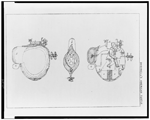 | 71k | Print shows three views of the American Turtle, a one-man submarine designed and built by David Bushnell to attach bombs to British warships during the American revolutionary war. | Digital ID # ggbain 3c10384v, LC-USZ62-110384. Source: Library of Congress Prints and Photographs Division, from the George Grantham Bain Collection, courtesy of Tom Kermen. | |
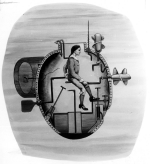 | 223k | David Bushnell's American Turtle, the first American submarine. Built in 1775, its intended purpose was to break the British naval blockade of New York harbor during the American Revolution. With slight positive buoyancy, American Turtle normally floated with approximately six inches of exposed surface. American Turtle was powered by a hand-driven propeller. The operator would submerge under the target, and using a screw projecting from the top of American Turtle , he would attach a clock-detonated explosive charge. This 1875 drawing by Lt. Francis Barber is the most familiar rendering of American Turtle. However, it contains several errors, including internal ballast tanks and helical screw propellers. | USN photo & text courtesy of chinfo.navy.mil. | |
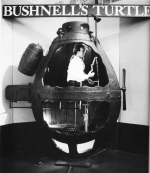 | 138k | This cutaway model of the American Turtle is in the submarine museum at Groton, CT. The cask on the back of the submarine is its weapon, containing 150 lbs of black powder with a clockwork time fuse, for a delay of up to 12 hours. Abaft the vertical propeller atop the hull is the screw by which means the bomb (which was roped to it) would have been attached to the hull of the target. Once the screw was firmly attached the boat was expected to submerge to release it and the bomb. The operator's hands hold cranks for both propellers; there were also foot pedals. Visible in the lower part of the boat are the forcing pump for water ballast and the rudder control rod (the control bar would be depressed for port and raised for starboard). The operator sat on a transevrse beam not visible here( it was inside the reinforcing band). Visible atop the hull is the hatch with its deadlights and, on the left, a ventillation pipe with a valve that would seal underwater. Not visible are 200 lbs of lead ballast that could be released on a 50-ft line, to be recovered if possible. (Submarine Force Museum & Library.) | Photo & text courtesy of U.S. Submarines Through 1945, An Illustrated Design History by Norman Friedman. Naval Institute Press. | |
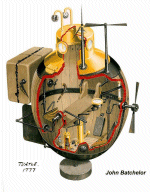 | 100k | This more recent drawing of American Turtle, is based on Bushnell's own written description, and is more accurate than the 1875 drawing by Lt. Barber. The most notable difference is the propeller; in Barber's drawing it is a helical screw, and here it is shown as a crude propeller. Also note that this drawing does not show ballast tanks. To submerge, the operator simply flooded water into the craft until it was negatively buoyant. This left the operator knee-deep in water. A hand pump was used to remove the water for returning to the surface. | Drawing courtesy of John Batchelor. USN photo & text courtesy of chinfo.navy.mil. |
|
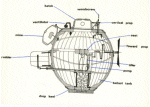 | 60k | Drawing of the American Turtle, at the Connecticut River Museum in Essex, CT., which owns the only working, full-scale model of David Bushnell's 1776 invention, the American Turtle. | Drawing courtesy of mayflowerfamilies.com. | |
 |
1.42k | SERGEANT EZRA LEE DIVED IN THE FIRST SUBMARINE IN 1776. ONE MUST DO THEIR HOMEWORK! |
Image and text provided by Library of Congress, Washington, DC. Photo & text by New-York Tribune.(New York [N.Y.]) 1866-1924, 05 June 1910, Image 21, courtesy of chroniclingamerica.loc.gov. Photo i.d. courtesy of Braydon Harris & Ric Hedman. |
|
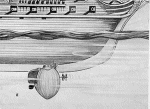 | 51k | Drawing of the American Turtle, attacking the HMS Eagle. | Drawing courtesy of nautilus571.com. | |
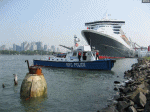 | 34k | A man hunkered inside a replica of a Revolutionary War submarine was arrested Friday, 3 August 2009 after police found the strange-looking vessel partly submerged in a security zone near the docked Queen Mary 2. The vessel and an inflatable boat were spotted by police near the luxury ocean liner docked at the cruise ship terminal in Red Hook, Brooklyn. Police arrested three men. New York City Police Commissioner Ray Kelly said the submarine did not represent a terror threat, but was "the creative craft of three adventuresome individuals." The brown, egg-shaped wooden vessel, known as a "turtle submarine," is a replica of a submarine American Turtle used during the American Revolution, said Coast Guard Petty Officer Angelia Rorison. It looks like a diving bell, with a hatch on top, and is about 8 feet long and 4 feet wide. It is propelled by a pedal-operated paddle. The Coast Guard issued two citations to Philip Riley, 35, of Brooklyn, who was inside the vessel, Rorison said. "Basically, the vessel was not safe to sail. It had no lights, no flares. It was not registered," she said. "Instead of safety violations, this could have turned into a search and rescue." The investigation began after a New York police detective noticed the sub and the raft and summoned the Harbor Unit. Rorison said all three men were taken in for questioning by the NYPD. "While our ongoing investigation has so far yielded no suspicious devices or materials other than the vessel itself, NYPD detectives will extensively examine Queen Mary 2 to ensure its integrity," said Kelly. "The three individuals believed responsible are in custody and may face various charges. Meanwhile we can summarize today's incident as marine mischief." | Photo & text courtesy of wnbc.com. | |
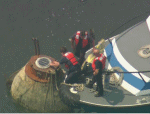 | 23k | A man hunkered inside a replica of a Revolutionary War submarine American Turtle was arrested Friday, 3 August 2009 after police found the strange-looking vessel partly submerged in a security zone near the docked Queen Mary 2. | Photo & text courtesy of wnbc.com. | |
Additional Resources and Web Sites of Interest
Building the Replica of David Bushnell's Turtle
Bushnell's Submarine
Submarine History / An Illustrated Survey of Key Events in Submarine History
| Back To The Main Photo Index | Back To the Submarine Index |
| Problems and site related matters, E-mail Webmaster |
| This page is created and maintained by Michael Mohl All Pages © 1996 - 2023, NavSource History All rights reserved. |